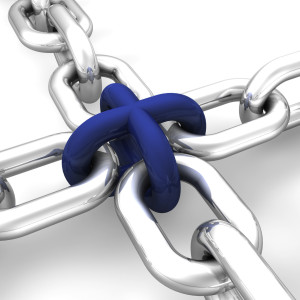…………………………
Now that you’ve established your goals and identified your customer, crafted a content marketing strategy, and written a few posts, it’s time to consider the best practices for promoting your content.
But let me back up, there’s something important I forgot to mention that you need to do before you hit the ‘publish’ button.
.
It’s important to carefully review any missed opportunities to establish hyperlinks within your post.
It goes without saying that you’ll promote your content across your social media platforms, but a second way to insure your post gets noticed is by leveraging your friends and followers within the post though hyperlinks. I think of it as putting the pieces of a jigsaw puzzle together, so the picture is visible to more people.
Here’s a great example;
A month ago fellow design blogger and good friend Patrick Hamilton penned a post on his blog Ask Patrick that leveraged the design community masterfully. What he accomplished will seem elementary to seasoned bloggers, but I’m spelling it out for those just starting out.
.
.
Faced with a career changing opportunity, namely designing his first showhouse room for this year’s Holiday House, Patrick reached out to the interior design community for help, and subsequently shared what he learned in his ‘Best In Show’ post. It made for great content.
Patrick established 45 (that I could count) hyperlinks in the post, to everyone from Jamie Drake, to Matthew Patrick Smyth, to The Alpha Workshops, to a myriad of other vendors. That’s important for 2 specific reasons.
First, because as each of the individuals and firms mentioned in his post shared the content, his influence multiplied; meaning there were more opportunities it would be read.
But perhaps more importantly, his hyperlinks create opportunities for organic back-links to his blog. Here’s a simplified explanation;
 Every time anyone on the internet links to Patrick’s post, by including the unique URL to it on Facebook, on Twitter, or on another blog, Google recognizes it; and rates the link based on associated key words. The more key words his blog has in common with the site that back-linked to him, the more confident Google is that it’s an organic link (versus one created by a robotic algorithm.)
Every time anyone on the internet links to Patrick’s post, by including the unique URL to it on Facebook, on Twitter, or on another blog, Google recognizes it; and rates the link based on associated key words. The more key words his blog has in common with the site that back-linked to him, the more confident Google is that it’s an organic link (versus one created by a robotic algorithm.)
The net result of Patrick’s accumulating organic back-links is Google raising his page rank. His page ranking on other platforms like Alexa and Technorati will go up as well.
Higher page ranks lead to higher positions in Google searches. For example, if Patrick has a Google Page rank of 3, while another blogger has a page rank of 2, and they both write a post on the same subject, his article will be higher in the search ranking.
The same would be true of 2 New York interior designers who also write blogs. Imagining one, we’ll call him Scott, who has a page rank of 3, and the other, we’ll call him Richard, who has a page rank of 5.
In a Google search of ‘New York Interior Designers’, Richard’s name and website will appear higher on the page – and higher on the page in a Google search equates to more web traffic. Ask yourself, how often have you gone on to page 2 of search results? There are untold number of SEO professionals devoted to getting people on the first page for a reason.
Follow this link for more background on Google’s recent Hummingbird algorithm shift.
Curious about your current page rank? Check it out.
.
And here’s one last bit of advise for promoting your content, check out Hootsuite if you aren’t already using it. You can preschedule Facebook posts, Tweets, and LinkedIn updates, so you don’t forget this step. Not familiar with the software? Here’s the clearest and most helpful tutorial I’ve found;
.
CJ Dellatore

